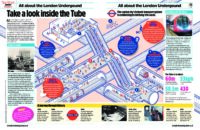‘Trains in drains’

Added to the Museum of Data by Sanat Rao on Monday, October 19, 2020. Museum of Data Collection ID: 558.
Public description: In a few months, it will celebrate its 177th birthday. The London Underground - or the 'tube' - is acknowledged as a outstanding piece of civil engineering that remains relevant, and indeed the very nerve-centre of London transportation to even this day. When the idea of 'trains in drains' was first mooted by Charles Pearson in 1845, The Times called it 'an insult to common sense'. And yet, in 2020, we cannot imagine the city without its 'underground'. It covers a vast expanse of territory, goes many layers below ground, at several stations it has multiple 'tubes' running cris-cross and with the proliferation of digital technologies, today it is available to all its users in the form of a simple app! The London Underground has certainly come a long way from when it was conceived
Materials used: iron shields, cast-iron segments, waterproof tubes, glass panels, groundwater cooling system, electrification, cooling system, signalling system, wifi hot spots at stations....
Credit: Sanat Rao (with references from https://en.wikipedia.org/wiki/London_Underground#:~:text=The%20Bakerloo%2C%20Central%2C%20Jubilee%2C,8%20inches%20(3.56%20m https://www.bbc.co.uk/newsround/46482813
Language: English
Size: 402 kilometres; over 1.3 billion passenger trips in 2018; over 470 escalators; top speed approx 60 mph; deepest station is at 58.5m below ground; 49 abandoned stations
Creation date: 2020/10/19 18:00:00
Other date: 2020/10/19 18:00:00
Alternate titles: A history of the London Underground
External link: https://en.wikipedia.org/wiki/London_Underground#:~:text=The%20Bakerloo%2C%20Central%2C%20Jubilee%2C,8%20inches%20(3.56%20m).
Tags: 4, 8, 11